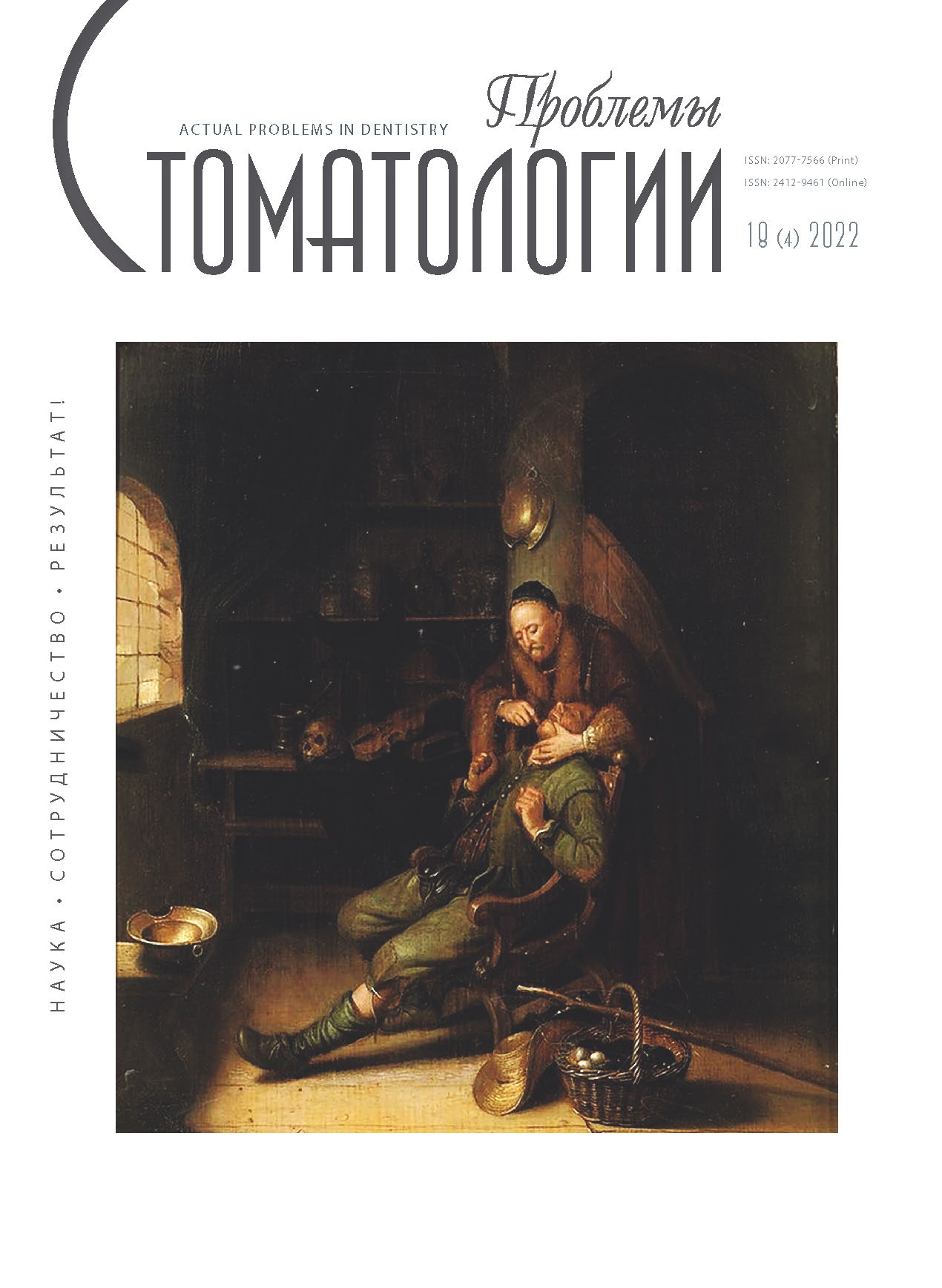Kazan', Kazan, Russian Federation
Moscow, Moscow, Russian Federation
employee
Moscow, Moscow, Russian Federation
Kazan', Kazan, Russian Federation
Objective. To develop a utilitarian technology for predicting the development of caries in individual teeth of adult patients for up to 2 years. Material and methods. A clinical examination was carried out with the subsequent entry of data into the author's questionnaire. With the help of system programming, a technology for individual prediction of the development of caries of individual teeth has been developed. We used the methods of descriptive statistics, discriminant analysis, digital technologies. Results. A technology has been developed for digital registration and assessment of risk factors (age, profession, marital status, dietary commitment, bad habits, time for brushing teeth, fluoridation, taking vitamins and dietary supplements) for the development of caries. The technology allows you to effectively predict the development of caries for up to 2 years on 1.2, 1.6, 1.7, 2.2, 2.3, 2.5, 2.6, 2.7, 2.8 teeth of the upper and 3.2, 3.3, 3.4, 3.6, 3.7, 4.4, 4.6, 4.7, 4.8 of the lower jaw with a classification accuracy of 50.0–92.6% and 50.4–77.3%, respectively. Conclusion 1. The use of digital technologies in dentistry for reliable registration and effective analysis of the studied risk factors makes it possible to predict the development of caries for up to 2 years on 1.2, 1.6, 1.7, 2.2, 2.3, 2.5, 2.6, 2.7, 2.8 teeth of the upper and 3.2, 3.3, 3.4, 3.6, 3.7, 4.4, 4.6, 4.7, 4.8 of the lower jaw with a classification accuracy of 50.0-92.6% and 50.4-77.3%, respectively. 2. Digital technology for predicting the development of caries of individual teeth contributes to the timely implementation of dental monitoring with high forecast accuracy for individual preventive hygiene measures, which is especially important to reduce the risk of enamel demineralization and the progression of dental diseases. 3. A technology has been developed for predicting the development of caries based on system programming with access and subsequent possibility of posting on the Internet.
tooth decay, prediction, individual tooth, technology, equation
1. Peres M.A., Macpherson L.M.D., Weyant R.J., Daly B., Venturelli R., Mathur M.R., Listl S., Celeste R.K., Guarnizo-Herreno C.C., Kearns C. et al. Oral diseases: A global public health challenge // Lancet. - 2019;394:249-260. https://doi.org/10.1016/S0140-6736(19)31146-8
2. Seredin P., Goloshchapov D., Kashkarov V., Nesterov D., Ippolitov Y., Ippolitov I., Vongsvivut J. Effect of Exo/Endogenous Prophylaxis Dentifrice/Drug and Cariogenic Conditions of Patient on Molecular Property of Dental Biofilm: Synchrotron FTIR Spectroscopic Study // Pharmaceutics. - 2022;14(7):1355. https://doi.org/10.3390/pharmaceutics14071355
3. Chen X., Daliri E.B., Kim N., Kim J.R., Yoo D., Oh D.H. Microbial Etiology and Prevention of Dental Caries: Exploiting Natural Products to Inhibit Cariogenic Biofilms // Pathogens. - 2020;9(7):569. https://doi.org/10.3390/pathogens9070569
4. Leont'ev V.K. Ob etiologii kariesa zubov. Institut stomatologii. 2019;1(82):34-35. [V.K. Leontyev. On etiology of dental caries. The Dental Institute. 2019;1(82):34-35. (In Russ.)]. https://instom.spb.ru/catalog/article/13315/
5. Skripkina G.I., Ekimov E.V., Mityaeva T.S. Sistemnyy podhod k probleme prognozirovaniya kariesa zubov. Problemy stomatologii. 2019;3(15):121-126. [G.I. Skripkina, E.V. Ekimov, T.S. Mityaeva. System approach to the problem of forecasting the caries of teeth. Actual problems in dentistry. 2019;3(15):121-126. (In Russ.)]. https://doi.org/10.18481/2077-7566-2019-15-3-121-126
6. Silagadze E.M., Salahov A.K., Ksembaev S.S., Baykeev R.F. Faktory, vliyayuschie na sostoyanie stomatologicheskogo statusa naseleniya Rossii. Problemy stomatologii. 2020;1(16):47-57. [E.M. Silagadze, A.K. Salakhov, S.S. Ksembaev, R.F. Baykeev. Factors affecting the dental status of the Russian population. Actual problems in dentistry. 2020;1(16):47-57. (In Russ.)].https://doi.org/10.18481/2077-7566-2020-16-1-47-57
7. Leus P.A., Kisel'nikova L.P., Boyarkina E.S. Otdalennyy effekt pervichnoy profilaktiki kariesa zubov. Stomatologiya. 2020;2(99):26-33. [P.A. Leus, L.P. Kisel'nikova, E.S. Boyarkina. The long-term effect of primary prevention of dental caries. Stomatology. 2020;2(99):26-33. (In Russ.)]. https://doi.org/10.17116/stomat20209902126
8. Udod O., Voronina H., Ivchenkova O. Application of neural network technologies in the dental caries forecast // Wiadomości Lekarskie. - 2020;73(7):1499-1504. https://doi.org/10.36740/WLek202007135
9. Prados-Privado M., García Villalón J., Martínez-Martínez C.H., Ivorra C., Prados-Frutos J.C. Dental Caries Diagnosis and Detection Using Neural Networks: A Systematic Review // Journal of Clinical Medicine. - 2020;9(11):3579. https://doi.org/10.3390/jcm9113579
10. Salahov A.K., Baykeev R.F., Ksembaev S.S., Silagadze E.M. Baza dannyh prognozirovaniya razvitiya kariesa otdel'nyh zubov srokom do 2-h let po dannym anketirovaniya i klinicheskogo obsledovaniya. Svidetel'stvo o gosudarstvennoy registracii bazy dannyh №2021622071. 04.10.2021. [A.K. Salakhov, R.F. Baykeev, S.S. Ksembaev, E.M. Silagadze. Database for predicting the development of caries of individual teeth for up to 2 years. Certificate RU №2021622071. 04.10.2021. (In Russ.)].
11. Bratthall D., Hansel-Petersson G. Cariogram - multifactorial risk assessment model for multifactorial disease. Community Dent // Oral Epidemiol. - 2005;33:256-264. DOI:https://doi.org/10.1111/j.1600-0528.2005.00233.x
12. Zaharova T.V., Zubareva G.M., Panteleev V.D., Kargapolov A.V., Shmatov G.P. Sposob prognozirovaniya kariesa zubov. Patent RU 2164350. 20.03.2001. [T.V. Zaharova, G.M. Zubareva, V.D. Panteleev, A.V. Kargapolov, G.P. Shmatov. A method for predicting dental caries. Patent RU 2164350. 20.03.2001. (In Russ.)]. https://patents.google.com/patent/RU2164350C1/ru



















